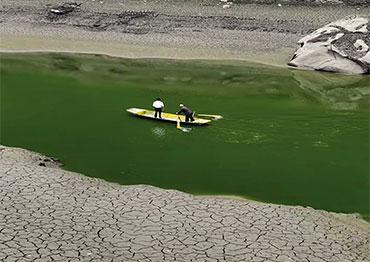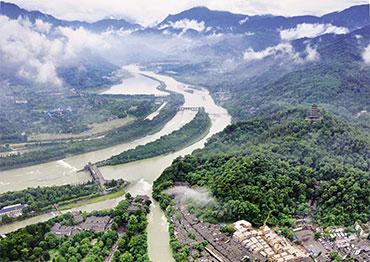In spring 2010, a severe drought in Sichuan affected over eight million people and caused direct economic losses of 1.3 billion yuan (US$180m). Chen Lei, who was in charge of the Ministry of Water Resources, pinned the blame on uneven distribution of the province’s abundant water resources. As well as regional geology, Chen said the drought was exacerbated by “insufficient large and medium-sized water-control projects and facilities, and a lack of supporting water diversion facilities.” There is an evident lack of built water storage solutions, he said.
Alleviating water shortages requires engineering, some experts believe. Yu Song said southern Sichuan should focus on “strengthening reservoirs, improving water diversion projects, and increasing the construction of water-saving facilities for farmland irrigation.”
The number of large reservoirs in Sichuan lags significantly behind the national average. According to the 2021 National Statistical Bulletin on Water Conservancy Development released by the Ministry of Water Resources in December 2022, 805 large reservoirs – with a capacity of over 100 million cubic meters – were built by 2021 in the Chinese mainland, with about 26 in each provincial administrative region. According to Sichuan Provincial Water Resources Department in April 2023, the province has only 10 large reservoirs.
Sichuan Province has a huge water storage gap, with far fewer conservancy projects relative to other provinces with a similar population along the Yangtze River. According to open statistics, combined storage capacity of reservoirs in Hubei Province amounted to 13.59 billion cubic meters in September 2022, and Hunan Province had a total water storage capacity of 23.807 billion cubic meters as of November 2022. Total storage capacity of water conservancy projects combined in Sichuan Province as of April 2022 was merely 8.109 billion cubic meters.
Yang Yong, a Sichuan-born geologist and director of the Hengduan Mountain Research Institute, is one of the first scientists to have investigated the geology and hydrology of the upper Yangtze. In terms of built storage capacity, Yang told NewsChina that the boom in hydropower in Sichuan has significantly changed the hydrological situation.
“Hydroelectricity development has boomed in the last three decades along rivers of various scale in Sichuan. These water diversion and hydropower projects changed the original hydrological situation of rivers. Insufficient planning and design of these water conservancy and hydropower projects resulted in the hidden problem of insufficient built water storage capacity,” Yang said.
Structural water shortage and water-quality-induced water shortage are also to blame, Yang said. In southern Sichuan, cities including Yibin, Luzhou and Zigong are key centers of economic growth. The original river system can no longer support the development momentum of urbanization and industrialization in the area, known as the South Sichuan Economic Zone.
As a result, Yang said, the Xiangjiaba water diversion project has been developed to transfer water from the existing Xiangjiaba Hydropower Project via canal pipelines to irrigate agricultural lands.
Xiangjiaba Dam, at the border of Sichuan and Yunnan, sits on the lower Jinsha River not far from where it meets the Min River at Yibin to become the Yangtze proper. It is China’s fifth-biggest hydropower station in terms of generation capacity and the 11th biggest in the world, as of 2022.
Extensive development has led to river pollution, water quality deterioration, and even loss of water resources in many water systems. These have caused water shortages due to poor water quality, Yang said. “This situation has slightly improved through better governance and industrial adjustment, but it hasn’t fundamentally changed. Southern Sichuan is a center for the chemical industry, including paper making, and there is still a very difficult and long way to go in addressing the pollution-induced water shortage,” he said. “Local and seasonal water shortages may occur in different periods and in different years in southern Sichuan. The present-day water shortage is a systemic, overall and even a long-term problem.”
On December 31, 2010, central authorities issued a decision that proposed to “accelerate the construction of key water source projects in southwest China and other areas suffering from built water storage shortages.” Accordingly, Sichuan Province stepped up efforts to build more water conservancy projects. Data released in May this year shows that total investment in water conservancy projects under construction in Sichuan has reached a record high of up to 130 billion yuan (US$18.2b).
The Xiangjiaba irrigation project, with a total investment of about 30.5 billion yuan (US$4.3b), according to an estimate by Sichuan Provincial Water Resources Department in 2020, is expected to serve more than a million people and significantly increase agricultural yields.
The official plan shows that the project will provide 1.782 billion cubic meters of water every year, irrigate 3,533 square kilometers of farmland, and provide supplemental water to 143 counties and towns with more than four million rural residents.
Its completion “will solve the water shortage issue of agricultural irrigation, urban and rural production and living water consumption, and improve drinking water security within the region,” a manager of Xiangjiaba Irrigation Project Construction and Development told NewsChina under condition of anonymity. The first phase of the project which started construction in December 2018 will cost 11.69 billion yuan (US$1.64b) and will go into operation in August 2024. The whole construction period is planned to last 15 years.
Water consumption per capita in Sichuan is much lower than the national average. According to a release by the Ministry of Water Resources in June 2022, China’s per capita water consumption was 419 cubic meters for 2021. Figures for 2021 released by the Sichuan Provincial Water Resources Department show per capita water consumption in Sichuan was 292 cubic meters in 2021, 127 cubic meters less than the national per capita level.
Data from the seventh national census found the permanent population in southern Sichuan was 14.47 million in 2020. To reach the national average per capita water consumption, total water consumption in southern Sichuan needs to increase by about 1.82 billion cubic meters. The belief is that if the Xiangjiaba irrigation area project functions as expected and it provides 1.78 billion cubic meters of water per year, southern Sichuan will no longer suffer water shortages.
Yang, one of a group of specialists who expressed concerns over big dam projects in the region, sounds a note of caution over whether China can “engineer” its way out of water shortages as a permanent solution. He feels that plans and the design of existing projects did not fully take into account issues like water shortages in surrounding areas, and that even the current Xiangjiaba diversion project may present future problems, which may require even more “engineered solutions.”
“China’s water resources management has always followed an ‘engineering mentality.’ The initial insufficient planning of [hydropower and water conservancy] projects may require follow-up adjustment projects, and further result in a vicious cycle,” said Yang.
New projects may be required to correct the initial shortcomings of earlier projects, he said. “The Xiangjiaba water diversion project has been decided and launched, but solutions like this that purely rely on [more] projects can’t solve the [systemic] problems,” he said.

 Old Version
Old Version


